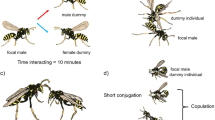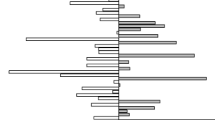Abstract
Living in high-density groups of animals has advantages and disadvantages for mating. The advantage of facilitated mate finding is compromised by difficulties in protecting a suitable partner from competitors. Thus, males regularly are faced with increased competition for sperm, and females with harassment by males at high population densities. To cope with these problems, mating tactics and mate choice mechanisms have to be adjusted. An adaptation to gregarious condition observed in locusts includes the use of male-emitted pheromones. Males of the Central American locust, Schistocerca piceifrons, release sex-specific volatiles, which were identified as phenethyl alcohol (synonym: phenyl-ethyl-alcohol, 2-phenyl-1-ethanol, 2-phenylethanol, PEA), (Z)-3-nonen-1-ol (3-Nol), and (Z)-2-octen-1-ol (2-Ool). The emission of the two major compounds, PEA and 3-Nol, was restricted to crowded conditions. Furthermore, the release of both volatiles was coupled to males reaching sexual maturity, indicating a function in reproductive behavior. However, neither the single substances nor their mixtures were attractive or repellent to the locusts. Instead, females prefer the sperm of high pheromone-emitting males to fertilize their ova. In this way, the male-specific volatiles act as mate assessment pheromones utilized in a context of cryptic female choice. This function is well supported by the highly variable but individual-specific emission rates of the three compounds. Schistocerca piceifrons males release a virtually unique personal pheromone signature, a prerequisite for mate assessment pheromones.







Similar content being viewed by others
References
Birkhead TR (1998) Cryptic female choice: criteria for establishing female sperm choice. Evolution 52:1212–1218
Birkhead TR, Pizzari T (2002) Evolution of sex: Postcopulatory sexual selection. Nat Rev Genet 3:262–273
Box GEP, Cox DR (1964) An analysis of transformations. J R Stat Soc 26:211–252
Capodeanu-Nägler A, Rapkin J, Sakaluk SK, Hunt J, Steiger S (2014) Self-recognition in crickets via on-line processing. Curr Biol 24:1117–1118
Danielsson I (1998) Mechanisms of sperm competition in insects. Ann Zool Fennici 35:241–257
Dillon R, Charnley K (2002) Mutualism between the desert locust Schistocerca gregaria and its gut microbiota. Res Microbiol 153:503–509
Eberhard WG (1996) Female control: sexual selection by cryptic female choice. Princeton University Press, New Jersey
Eberhard WG (2009) Postcopulatory sexual selection: Darwin's omission and its consequences. Proc Natl Acad Sci U S A 106:10025–10032
Fisher RA (1958) Sexual reproduction and sexual selection. In: Fisher RA (ed) The genetical theory of natural selection: a complete variourum edition. University Press, Oxford, pp. 121–145
Gotham S, Song H (2013) Non-swarming grasshoppers exhibit density-dependent phenotypic plasticity reminiscent of swarming locusts. J Insect Physiol 59:1151–1159
Groot AT, Schöfl G, Inglis O, Donnerhacke S, Classen A, Schmalz A, Santangelo RG, Emerson J, Gould F, Schal C, Heckel DG (2014) Within-population variability in a moth sex pheromone blend: genetic basis and behavioural consequences. Proc R Soc B 281:1–10
Grunshaw JP, Guermouche H, Guermouche S, Jago ND, Jullien R, Knowles E, Perez F (1990) Chemical taxonomic studies of cuticular hydrocarbones in locusts of the Schistocerca americana Complex (Acrididae, Cyrtacanthacridinae): chemical relationships between new world and old world species. J Chem Ecol 16:2835–2858
Gu Y, Lucas P, Rospars J-P (2009) Computational model of the insect pheromone transduction cascade. PLoS Comput Biol 5:1–23
Harvey AW (1981) A reclassification of the Schistocerca americana Complex (Orthoptera: Acrididae). Acrida 10:61–77
Hernández-Zul MI, Quijano-Carranza JA, Yáñez-López R, Ocampo-Velázquez RV, Torres-Pacheco I, Guevara-González RG, Castro-Ramírez AE (2013) Dynamic simulation model of central American locust Schistocerca piceifrons (Orthoptera: Acrididae). Fla Entomol 96:1274–1283
Hunter-Jones P (1966) Rearing and breeding locusts in the laboratory. Centre for Overseas Pest Research Publication, London
Johansson BG, Jones TM (2007) The role of chemical communication in mate choice. Biol Rev 82:265–289
Jones AG (2002) The evolution of alternative cryptic female choice strategies in age-structured populations. Evolution 56:2530–2536
Jones TM, Hamilton JGC (1998) A role for pheromones in mate choice in a lekking sandfly. Anim Behav 56:891–898
Kvarnemo C, Simmons LW (2013) Polyandry as a mediator of sexual selection before and after mating. Philos Trans R Soc B Biol Sci 368:1–16
Legendre P, Legendre L (2012) Numerical Ecology. In: Developments in environmental modelling, vol 24, 3rd edn. Elsevier, Amsterdam, pp. 1–990
Lessells CM, Boag PT (1987) Unrepeatable repeatabilities - a common mistake. Auk 104:116–121
Lewis SM, Austad SN (1994) Sexual selection in flour beetles - the relationship between sperm precedence and male olfactory attractiveness. Behav Ecol 5:219–224
Lovejoy NR, Mullen SP, Sword GA, Chapman RF, Harrison RG (2006) Ancient trans-Atlantic flight explains locust biogeography: molecular phylogenetics of Schistocerca. Proc R Soc Lond B 273:767–774
Mahamat H, Hassanali A, Odongo H (2000) The role of different components of the pheromone emission of mature males of the desert locust, Schistocerca gregaria (Forskål) (Orthoptera: Acrididae) in accelerating maturation of immature adults. Int J Trop Insect Sci 20:1–5
Miller DR, Borden JH, Slessor KN (1989) Interpopulation and intrapopulation variation of the pheromone, ipsdienol produced by male pine engravers, Ips pini (say) (Coleoptera, Scolytidae). J Chem Ecol 15:233–247
Moore AJ (1994) Genetic evidence for the good genes process of sexual selection. Behav Ecol Sociobiol 35:235–241
Moore AJ, Gowaty PA, Wallin WG, Moore PJ (2001) Sexual conflict and the evolution of female mate choice and male social dominance. Proc R Soc Lond B 268:517–523
Moore AJ, Gowaty PA, Moore PJ (2003) Females avoid manipulative males and live longer. J Evol Biol 16:523–530
Pölkki M, Krams I, Kangassalo K, Rantala MJ (2012) Inbreeding affects sexual signalling in males but not females of Tenebrio molitor. Biol Lett 8:423–425
Rantala MJ, Kortet R, Kotiaho JS, Vainikka A, Suhonen J (2003) Condition dependence of pheromones and immune function in the grain beetle Tenebrio molitor. Funct Ecol 17:534–540
Seidelmann K (2006) The courtship-inhibiting pheromone is ignored by female-deprived gregarious desert locust males. Biol Lett 2:525–527
Seidelmann K, Ferenz HJ (2002) Courtship inhibition pheromone in desert locusts, Schistocerca gregaria. J Insect Physiol 48:991–996
Seidelmann K, Weinert H, Ferenz HJ (2003) Wings and legs are production sites for the desert locust courtship-inhibition pheromone, phenylacetonitrile. J Insect Physiol 49:1125–1133
Seidelmann K, Warnstorff K, Ferenz HJ (2005) Phenylacetonitrile is a male specific repellent in gregarious desert locusts, Schistocerca gregaria. Chemoecology 15:37–43
Song H (2004) Revision of the Alutacea group of genus Schistocerca (Orthoptera: Acrididae: Cyrtacanthacridinae). Ann Entomol Soc America 97:420–436
Song H (2011) Density-dependent phase polyphenism in nonmodel locusts: a minireview. Psyche:1–16
Stahr C, Svatos A, Seidelmann K (2013) Chemical identification, emission pattern and function of male-specific pheromones released by a rarely swarming locust, Schistocerca americana. J Chem Ecol 39:15–27
Sword GA (2003) To be or not to be a locust? A comparative analysis of behavioral phase change in nymphs of Schistocerca americana and S gregaria. J Insect Physiol 49:709–717
Todd JL, Baker TC (1999) Function of peripheral olfactory organs. In: Hanson BS (ed) Insect olfaction. Springer, Berlin, Heidelberg, pp. 67–97
Wilson K, Thomas MB, Blanford S, Doggett M, Simpson SJ, Moore SL (2002) Coping with crowds: density-dependent disease resistance in desert locusts. Proc Natl Acad Sci U S A 99:5471–5475
Acknowledgement
We are grateful to M. Poot Pech for collecting the locusts and providing us with useful background information, and to P. Lindemann (Dep. Pharmac. Biotech., Univ. Halle) for performing the sterioisomeric analysis. For technical assistance and maintenance of the locust culture we thank S. Hertel.
Author information
Authors and Affiliations
Corresponding author
Electronic supplementary material
ESM 1
(DOC 997 kb)
Rights and permissions
About this article
Cite this article
Stahr, C., Seidelmann, K. Individual Pheromone Signature in Males: Prerequisite for Pheromone-Mediated Mate Assessment in the Central American Locust, Schistocerca Piceifrons . J Chem Ecol 42, 1304–1313 (2016). https://doi.org/10.1007/s10886-016-0793-9
Received:
Revised:
Accepted:
Published:
Issue Date:
DOI: https://doi.org/10.1007/s10886-016-0793-9




